Poultry Diseases
Feather Pecking
Also known as: Cannibalism
Feather pecking is not confined to domestic hens, but is also common in pheasants, turkeys, partridges, parrots and a variety of other birds when these are kept intensively.
The severity of feather pecking in poultry flocks can range from gentle feather pecking to an extreme and aggressive form recognised as cannibalism. A degree of feather pecking may be considered a natural preening process and also part of the natural establishment of the pecking order, but under deprived conditions it results in considerable health and welfare problems.
It is a multi-factorial problem which may be associated with nutrition, the housing and range environment, management, breeds and breeding, and is closely associated with stress. Here we are considering the incidence and control of feather pecking under free-range conditions, which in certain situations, provide a different set of influential factors than caged systems.
The FeatherWel Project
We recommend that all farmers and advisors interested in learning more about the management of feather pecking visit the FeatherWel project website at www.featherwel.org.
The FeatherWel Project aims to provide advice on practical strategies to reduce the risk of injurious pecking occurring in non-cage laying hens during both the rearing and laying periods. The support for these strategies is based on scientific evidence, experience from industry and the results of the Bristol Pecking Project. This project website summarises the key management strategies that have been found to prevent and reduce injurious pecking in laying flocks.
Incidence In Free Range Systems
Where feather pecking and cannibalism exist, it can usually be linked to an underlying issue with the farming system that triggers the problem. This has been shown to be the case in aviary, high density, deep litter systems and straw yards (Loliger, Hagen, and Mathes, 1980; Loliger, 1985 and Gibson et al, 1988). Keeling et al, 1988 observed an outbreak of cannibalism in a free-range flock that occurred primarily in the last 8 weeks of lay. Cannibalism and pecking have also been observed in other free range flocks in England (Swarbrick, 1986). Green et al (2000) conducted an extensive postal survey of “alternative” poultry systems in the UK and showed that over 55% of respondents reported feather pecking in laying flocks. In Denmark, organic flocks have been shown to differ markedly in degree of feather pecking (Hegelundl et al., 2006), with plumage condition ranging between flocks from almost perfect to severely damaged. A survey of Dutch organic flocks showed no or little plumage damage in 29% of flocks, moderate damage in 19% flocks and severe damage in 52% (Bestman and Wagenaar, 2003).
In Relation to Social Behaviour
Feather pecking is viewed by some as misdirected feed pecking, deriving either from a foraging or a dustbathing background, influenced by social dominance or “pecking order” and only occasionally associated with aggressive behaviour (Wennrich, 1975). Early feather pecking could be interpreted as social exploration (Rodenburg et al., 2004a). Differences in feather pecking behaviour between high and low feather pecking breed lines can be observed at a very early age and may be related to differences in underlying motivational system controlling this behaviour (van Hierden et al., 2002).
Development into Cannibalism
Cannibalism may follow on from feather pecking especially if feed is deficient, but may also arise independently. Cannibalism has been observed as starting with the pecking of fresh wounds in the back or excretory channels of a hen by nearby birds. Such pecking does not appear to be aggressive in character but to be part of normal feeding behaviour. The attacked birds are usually silent and make little attempt to escape. Pecking often continues until part of the intestine is obtained. Death follows, usually within 10 minutes, but pecking of the corpse continues.
Victims that have been attacked on the back, wings, rump, tail, cloaca, abdomen and toes have been shown to be more asymmetrical and tended to have lower body weights than their flock mates. Victims of cannibalistic attacks to the heads have been shown to have larger combs than their flock mates, indicating that large combs either elicit attacks to the head and neck area, or increase vulnerability to injury during such attacks. Cannibals appeared not to differ in skeletal or ornamental traits from non-cannibalistic birds (Cloutier and Newberry, 2002).
Preen oil derived from the preen gland has previously been shown to differ in its composition between birds of different ages, sex and diet. Changes in preen oil composition with age may be due to changes in circulating concentrations of hormones. Differences in preen oil composition between feather pecked and non-pecked birds may influence plumage odour and therefore taste, making the plumage of some birds more attractive to pecking than others (Sandilands et al., 2004).
Environmental Risk Factors
The causes of feather pecking are closely linked with the nature of the environment in which the bird is kept (Hughes and Duncan, 1972). Although the causes of cannibalism are not fully understood, there are known to be many predisposing factors, such as overcrowding, excessive light and temperature, insufficient or improperly placed feeder or drinking space, nutritional imbalances, including mineral deficiencies, feeding of only pelleted or concentrated feed, feeding high energy feeds and injuries. Green et al., 2000 and the University of Bristol, 2001 confirmed the importance of many risk factors that have been suggested in the literature following experimental work, or identified by experts after years of practical experience.
In summary, stimulating feeding and foraging behaviour by providing high-fibre diets and suitable litter from an early age onwards, and controlling fear and stress levels through genetic selection, reducing maternal stress and improving the stockmanship skills of the farmer, together offer the best prospect for preventing or controlling feather pecking (Rodenburg et al., 2013).
Feather pecking and vent pecking were positively correlated and shared some common risk factors. The following were associated with feather pecking:
- Fewer than 50% hens using the outdoor area
- No loose litter left by the end of lay
- Water provided via bell drinkers
- More than 3 diet changes during lay
- House temperature >20C
- Light levels raised to inspect birds
- Use of lights in nest boxes
- One person inspecting the flock
The following were associated with vent pecking (reported by Pötzsch et al (2001):
- Less than 25% of the flock using outdoor area
- More than 3 diet changes
- Use of hanging drinkers
- Birds came into lay at <20 weeks of age
Feeding and Nutrition
There are two main issues with regard to feeding and nutrition: the composition of the feed and the manner in which it is offered.
Feed Composition
Van Krimpen et al, (2005) conducted a comprehensive review of the relationship between nutrition and feather pecking, highlighting the negative effects of diets too high in minerals, protein or low amino acid level, especially methionine and arginine. Birds fed diets of mainly vegetable protein, compared with protein from animal origin have been shown to be more likely to feather peck, as has restricted feeding and feeding coarsely ground or pelleted feed. High dietary protein levels associated with sub-deficiency in lysine might favour cannibalism in meat label chickens during the finishing stage, more than low dietary protein levels (Quentin et al., 2005). It has been suggested that poor feathering and the high mortality rate due to cannibalism could be due to inadequate lysine, methionine and threonine in low protein diets (Ambrosen and Petersen, 1997) High-fibre and low energy diets and roughages can all contribute to reducing feather pecking (Van Krimpen et al., 2005; Hetland et al 2004).
Providing cut straw in the laying areas (Norgaard-Nielson et al., 1993) and access to maize silage, barley-pea silage or carrots (Steenfeldt et al., 2007) have again all been found to have positive effects in reducing injurious feather pecking. It may be the case that with nutrients disappearing from the lumen faster, and digesta moving through the gut quicker, birds spend longer time eating and less time pecking each other. The ability of insoluble fibre to exert these effects is related to particle size, as fine grinding diminishes its stimulatory influence on the gizzard.
Foraging and Feeding
Unlike wild birds, poultry are provided with a constant source of feed, and may therefore spend some time feather pecking. This is an important difference in feather pecking between ranging and caged hens. Potentially, free-range hens spend time foraging and less time pecking other birds.
Increasing opportunities for foraging and feeding is important as there is evidence suggesting that feather pecking is redirected ground pecking behaviour associated with foraging (Blokhuis, 1986; Huber-Eicher and Wechsler, 1997; Ramadan and von Borell, 2008). The manner in which feeds are offered to laying birds appears to be influential and feeding pelleted feeds have been associated with feather pecking, with evidence to suggest that feeding mash is preferable as birds spend more time feeding (Aerni et al., 2000; El-Lethey et al., 2000; Hartini et al., 2002).
Frequent diet changes can also influence birds’ propensity to feather peck (Gilani et al., 2010). More than 3 changes to diets during the laying period presents a risk of feather pecking Green et al., 2000; Pötzsch et al., 2001 .
Good foraging is one of the major factors in reducing feather pecking and severe feather pecking in particular can be derived from frustrated motivation to forage (Dixon et al, 2008). Curtis and Marsh (1993) suggest that changes in palatability of food may lead to birds becoming ‘peckers’, initially seeking alternative sources of food, which by chance may lead to vent pecking.
Bedding
Although type of litter in deep-litter houses has been shown to have no clear influence in inducing or preventing feather pecking, trials have shown that there were more cases of cannibalism and bleeding injuries due to pecking and pulling at tail feathers in birds housed on fine sawdust (Dittrich-Prolss ,1987). Provision of litter may also be key and again the absence of loose litter, including periodic absence, have been observed as being an important pre-disposing factor for feather pecking (Green et al., 2000).
Provision of adequate litter can be critical, especially if in a friable state, and has been shown to reduce the incidence of feather pecking.
Access to Range and Ranging
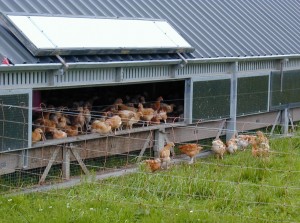
Access to the range can be a contributory factor, including all the factors that in turn influence the freedom to range, including size of pop-hole
It appears that there is less feather pecking in situations where a large proportion of hens spend time outdoors simultaneously (Green et al., 2001; Bestman and Wagenaar, 2003; Nicol et al., 2003). Nicol et al. (2003) indicate that the risk for feather pecking was nine times less if at least 20% of the hens went out simultaneously.
Environmental enrichment, low chicken density and good air quality can all encourage the use of the outdoor run and reduce feather pecking (Bestman, 2004). However, in large groups (more than 500) the proportion of hens outdoors is often very low (Keeling et al., 1988; (Appleby and Hughes, 1991) Bubier and Bradshaw, 1998; Bestman and Wagenaar, 2003; Zeltner and Hirt, 2003).
A number of measures can be used to encourage birds to make full use of the range, including the presence of trees and/or hedges (Nicol et al., 2003) or other vegetation and/or cover. Flocks of hens containing cockerels have been shown to exhibit less fear, which encourages greater ranging behaviour (Oden et al, 2005; Bestman and Wagenaar, 2003). Smaller flocks (less than 500 birds) are also more likely to use outdoor space, as do hens housed with popholes (exit doors) of sufficient size.
Please see our welfare section for more information on Encouraging Ranging Behaviour.
Rearing Management
It is becoming increasingly clear that feather pecking frequently develops early in life (Kneirem et al., 2008; Bestman et al., 2009; Drake et al., 2010). This may not always be very apparent, as young birds moult several times so plumage damage is usually subtle (Gilani et al., 2010). Plumage condition at the age of 28 weeks can provide a possible early indicator of the future welfare status of the flock and hence provide knowledge on the need for increased management to prevent and reduce feather pecking during the subsequent laying period (Hegelundl et al., 2006).
Providing enriched conditions and appropriate feeding during rearing may be key. Chicks deprived of environments that promote exploration may re-direct this behaviour toward other birds, which may lead to the development of feather pecking (Chow and Hogan, 2005). Access to litter from one day of age helps to encourage foraging behaviour and reduce feather pecking (Huber-Eicher and Sebö, 2001). Re-emphasising the importance of ranging behaviour, a strong, negative genetic correlation was found between open-field activity at young age and pecking behaviour at adult age, suggesting open-field activity levels in young birds may predict pecking behaviour in adult hens (Rodenburg et al., 2004b).
The presence of hens during rearing may also have preventive effects, especially broody hens (Riber et al., 2007). They have been observed as having positive impacts on development, encouraging ground pecking activity and the early use of daytime perches, which in turn helps to reduce the incidence of feather pecking and cannibalism. The provision of perches and a foraging and dustbathing environment during rearing, including early introduction to the range, reduces the stresses of moving from rearing to laying conditions, and again may reduce injurious pecking (van de Weerd and Elson, 2006, Gunnarsson et al., 1999).
The stockperson can be critical and it has been shown that the probability of severe feather pecking is reduced when the main caretaker had a number of years of experience. This is particularly true during the rearing period. It has also been shown that birds observed and inspected by more than one person during rearing are less likely to feather peck, possibly because this increases the chance of spotting faults with rearing, but also being used to more than one individual may reduce susceptibility to stress (Gilani et al., 2010). This effect was also observed in laying hens (Green et al., 2000).
Social learning may contribute to the spread of cannibalistic behaviour. Cloutier et al (2002) suggest that stimulus enhancement and observational conditioning were the social-learning mechanisms involved. Contrary to common hypotheses, Riedstra and Groothuis (2002) argue that gentle feather pecking at an early age plays an important role in the building (social exploration) and maintenance of social relationships between chicks. Rodenburg et al (2004c) indicate that rearing conditions influence feather pecking, but not reaction to frustration.
Environmental Enrichment
Environmental enhancement can help reduce risks of feather pecking, for example, the addition of simple string devices (McAdie et al., 2000), and in particular white string (Jones et al., 2000). Providing perches of the right height can be important, and Wechsler and Huber-Eicher (1998) found perches 70cm rather than 45cm above floor level to be influential.
Resting and refuge areas enables less active birds to avoid mixing with active birds and this can help avoid being targeted for both gentle and severe feather pecking (Friere et al., 2003; Riber and Forkman, 2007).
Drinking Facilities
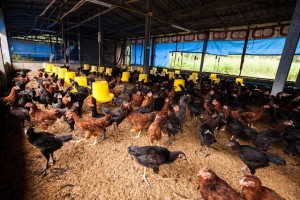
Bell drinkers, as compared with nipple drinkers, are considered one of the many risk factors, possibly because of water spillage
Insufficient or improperly placed feeder or drinking space can be a factor in encouraging feather pecking, and there is evidence of differences between the type of drinking facility used. Green et al., 2000 and Pötzsch et al (2001) identified the use of hanging bell drinkers to be a potential risk factor.
The association between the use of bell-drinkers and feather pecking may be due to water spillage producing wet and compacted litter. Also, compared with nipple drinkers, they are a clustered water supply, which may create a focus for competition (Lindberg and Nicol, 1996). Zimmerman et al (2005) found an improved litter management strategy and the use of nipple drinkers rather than bell drinkers contributed to a reduced level of feather pecking, although there is anecdotal evidence suggesting the opposite case with regard to type of drinker (D.Shingleton, pers.comm).
Behaviour
Cannibalism has also been noted to start with vent pecking, frequently soon after a bird has finished laying, when the vagina is still partly open. This is partly why nesting boxes need to be in a darkened place. The failure of pecked birds to escape has been associated with both ‘learned helplessness’ and affiliative behaviour. Learned helplessness is judged to be a state in which animals eventually become passive in reaction to suffering they cannot avoid. Affiliative behaviour is the flocking behaviour displayed by free-ranging hens, and includes the habit of pecking food off a bird that remains perfectly still. The failure to escape may be the result of birds being confused into this activity as a result of high levels of stocking (Appleby, Hughes and Elson, 1992).
The trigger for aggressive behaviour can be one or more of many factors. Attention to the management features will reduce the stress conditions which can trigger aggression, but other factors, ranging from the presence of enrichment to sub-clinical infections to the irritation of parasites like lice or mites, can also be to blame. Feather eating, which is due to a nutritional protein and amino acid deficiency, can often lead to feather pecking and then to vent pecking.
Flock Size Is Important
Domestic chickens naturally live in small groups, with a dominance hierarchy (pecking order) which is most likely based on establishment fights, followed by remembered assessment of status involving individual recognition. In larger groups, this system is thought to breakdown. Hens in small groups, but not large groups, have been shown to discriminate between familiar and unfamiliar subjects by showing more aggression towards unfamiliar hens. In large groups (but not in small), hens that approached and were aggressive were both heavier and had larger combs than the subjects. These findings are consistent with the idea that in large groups hens become less aggressive and may change their social system to one where dominance is determined through direct assessment and ‘status signalling’ rather than the remembered individual assessment of a small group pecking order (D’Eath and Keeling 2003). Although rare, aggressive pecking was most common in small flocks of low stocking density. This was related to birds attempting to form social hierarchies, whereas large flocks at high density appear to adopt non-social, non-aggressive behavioural strategies (Nicol et al, 1999).
Overcrowding of birds in particular can encourage feather pecking. Organic systems, with low stocking rates, are likely to discourage this vice. Using small mobile housing or partitions in larger houses to create small flocks can be beneficial as it has been shown that feather pecking is generally lower in hens kept in smaller groups (Bilcík and Keeling, 2000; Nicol et al, 1999).
There is also an indirect link with flock size in that a lower proportion of birds in large flocks spend time ranging outdoors (Appleby and Hughes, 1991 and Hirt et al., 2000) and hence are at a greater risk of feather-pecking (see Environmental Risk Factors above). In larger commercial flocks, the distinction between flocks of different sizes is less obvious, with no apparent association between percentage of hens recorded outside the house (veranda or free-range) and flock size. However, individual hens in small (2000 to 2500 bird flocks) and medium sized flocks (5000 to 6000 bird flocks) have been shown to visit outside areas and forage more frequently and spent more time there than hens from larger flocks (Gebhardt-Henrich et al., 2014).
Breed, Breeding and Type
Feather pecking and cannibalism are common in females and rare in males. Hughes (1973) implicated circulating hormonal balance as being an important factor. Cuthbertson (1980) showed a genetic influence, indicating some birds are more likely to feather peck than others. Offspring of hens who feather pecked are more inclined to show feather pecking behaviour than those from non-feather pecking hens (Keeling and Wilhelmson, 1997). Feather peckers are also more active than non-feather pecking birds.
Feather pecking has been shown to be heritable and genetic regions involved in feather pecking have been identified (Rodenburg et al., 2004a). Bennewitz et al (2014) showed that selection might help to reduce feather pecking, but this might result in reduced egg production.
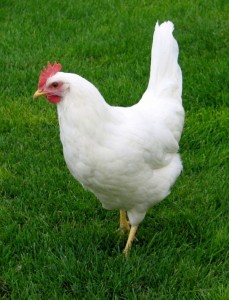
Different strains of White Leghorn hen have differing tendencies to feather peck (from www.healthygreenerworld.com)
There can be significant breed differences in tendency to feather peck and cannibalism (Hocking et al, 2004). Schlolaut and Lange (1977) showed differences between strains of White Leghorn hens. When birds selected under cage systems are raised on floors due to a change in consumer demand from cage-produced eggs to eggs from birds on floor production systems, as is the case in Denmark, there is increased cannibalism and feather pecking. This scenario may arise as a result of selection for egg production in hens kept in cages which in turn may have resulted in a loss of genes for social interaction (Sorensen and Christensen, 1997) . Birds from a low feather pecking genetic line may show greater sociality (motivation to be near companions) and a passive ‘coping’ style, although social transmission of gentle but not severe pecking can occur when lines with opposite feather pecking tendencies are housed together (Hocking et al, 2004).
Gentle feather pecking and open-field behaviour may be used in selection against feather pecking (Rodenburg et al., 2003). Birds from high and low feather pecking lines that show differences in feather pecking have also been shown to differ in other behavioural and physiological characteristics and this may reflect line differences in coping strategy (Rodenburg et al., 2004a). However, Albentosa et al (2003) casts doubt on the usefulness of tests as predictors of feather pecking, suggesting hens cannot easily be categorised into different behavioural ‘types’, based on their test responses.
Birds with a low feather pecking genotype also had a stronger motivation for foraging or dust-bathing behaviour. The more docile broiler breeds are rarely implicated, but the hybrid layers and turkeys are very susceptible. Chickens are by nature territorial and so due consideration must always be given to suitable stocking densities and the innate competition for food and water. Sorensen (1996) gives an account of the genetic effects on behaviour in fowls managed in cages or on the floor (including cannibalism and feather pecking), and discusses their importance for the selection of strains suitable for “ecological management”.
Crooijmans et al (2003) suggest that gentle feather pecking at different ages is regulated by different genes in young and adult hens. The occurrence of feather pecking and cannibalism in some breed crosses (e.g. Labresse cross as compared with Ross 208) make their use in outdoor meat-type poultry production questionable (Nielsen et al., 2003). In two lines of White Leghorns differing in their tendency to feather peck there was a noticeable line difference after 3 days of birth. Mahboub et al (2004) found the negative correlation between feather damage and time spent outside suggests that feather pecking risk decreases in genotypes attracted to grassland.
Under free-range conditions, mortality from cannibalism has been shown to be higher in ISA Brown than in the New Hampshire and White Leghorn breeds and a cross between New Hampshire and White Leghorn (Kjaer and Sorensen 2002). Leenstra et al (2012) observed over a large number of free-range systems that white hens had a better feather cover than brown hens, while feather scores for silver hens were lowest. They cite anecdotal information suggesting that birds descended from Rhode Island Red (present in most/all brown genotypes) have an increased tendency for feather pecking and cannibalism, although this was not confirmed in experiments by reported by (Elwinger et al. (2008).
Breed types selected for commercial laying conditions are normally selected under cages and closed house situations, and hence their suitability for free-range conditions, including the impact of associated higher energy requirements, have not been tested and hence may not be appropriate (Leenstra et al., 2012).


 American English
American English
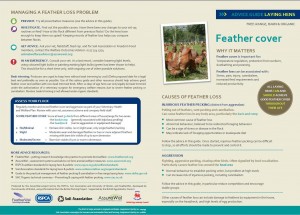
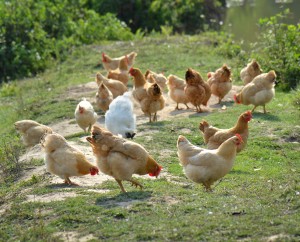
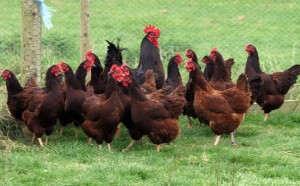

Comments are closed.